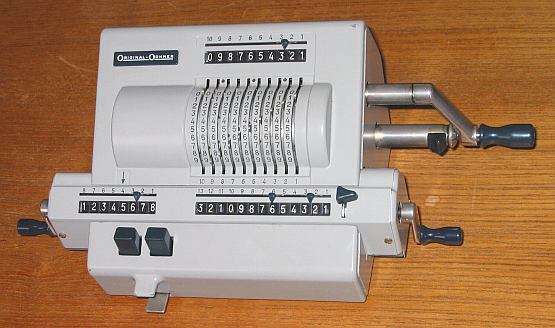previous <<==>> next
ORIGINAL - ODHNER MODEL 239 |
"How to Restore/Maintain?" ==>> See WorkShop ODHNER-239
TECHNICAL DATA of the Mechanical Calculator O D H N E R » Model 239 «
**************************************************************************
Designed by S. Bernadotte, Member of the Swedish Royal family
Serial Number: 239-891970 ( Chassis = 166211 )
Dimensions: (ca.) Width = 13 " / 33 cm
Depth = 7 " / 18 cm
Height = 5 " / 13 cm
Weight: (ca.) 13_1/2 lbs / 6.2 kg
Mechanics: Pin-Wheel / Sprossenrad
10s Carry Mechanism
Functions: Add, Subtract, Multiply, Divide
Back-Transfer / Rueckuebertragung
Registers: Input = 10 Decimals
Counter = 8 Decimals
Arithmetic = 13 Decimals
Manufacturer:
ORIGINAL-ODHNER
Goeteborg / Sweden
1955
H O W T O U S E the ODHNER Model 239
********************************************
BASIC SETTINGS:
===============
(a) Main Crank:
---------------
For addition (+) the crank is turned clockwise; for subtraction (-) the
crank is turned counter-clockwise. In idle position the crank is down &
locked. To make one or more turns with the crank, pull out the handle
to unlock. When finished the turn(s), let the handle snap into the lock
again. The locked down position only makes other functions accessible.
REMARK: Every started turn has to be finished completely!
Accidentally started turns are correctible somehow.
(b) Clearing Registers:
-----------------------
Procedure to clear the Input:
Push the BLACK BUTTON beside the crank (with the thumb) left and
turn the crank 1/4 clockwise until all input-levers (and display)
are reset. Than turn the crank COUNTER-CLOCKWISE back and let the
handle snap into the lock position.
The Counter Unit
will be cleared with the CRANK on the LEFT SIDE of the carriage
The Arithmetic Register
will be cleared with the CRANK on the RIGHT SIDE of the carriage
(c) Shifting the Carriage:
--------------------------
Pressing down the LEFT or RIGHT BUTTON IN FRONT will move the carriage
one step left or one step right. When the SILVER KEY is pressed, the
carriage can be moved continuously right or left by hand.
The left position "1" is the "Start Position" of the carriage.
(d) Counting Direction:
-----------------------
It depends of the 1st turn of the crank how the counter is switched to
(+) or (-). The counter will increase its content for positive (clock-
wise) or negative (counter-clockwise) turns. When the direction of the
turns is changed, the counter will decrease its content. In both cases
the counter is working with 10s-carry - and allows "Shortened Method of
Multiplication".
(e) Back Transfer:
------------------
For continuous multiplication the contents of the arithmetic unit
can be back transfered into the input register with this procedure:
o Clear input register as described above.
o Pull the BLACK KEY right on the arithmetic unit.
o Make a "CLEAR" (clockwise) turn for the arithmetic unit.
This clears the arithmetic unit ...
and set the input levers (and its display) to the transfer-value.
ADDITION & SUBTRACTION:
=======================
Example: 123 + 45 - 6 = 162
Clear input, counter and arithmetic units.
ADD: Enter the first number (123) in the far right of the input unit.
Make a positive (clockwise) turn with the crank to transfer the number
into arithmetic unit. The counting unit displays the figure 1. Enter the
second number (45). Make a positive (clockwise) turn with the crank to
add the number. The arithmetic unit displays the intermediate sum (168)
and the counting unit displays the figure 2.
SUBTRACT: Enter the third number (6). Make a negative (counter-clockwise)
turn with the crank. The arithmetic unit displays the result (162) and
the counting unit is decreased by 1.
REMARK: NEGATIVE RESULTS are displayed in the arithmetic unit
as the COMPLEMENT of the next higher 10, 100, 1000, ...
Example: -12 = 99...9988
MULTIPLICATION:
===============
Example: 123 x 45 = 5535
Clear input, counter and arithmetic units.
Enter the multiplicand (123) in the far right of the input unit. The
multiplicator (45) has two digits, so the carriage is shifted to
position 2. Make positive (clockwise) turns with the crank, until the
first figure of the multiplicator (4) will appear in the 2nd position of
the counter unit. Shift the carriage to position 1. Repeat making positive
turns with the crank, until the second figure of the multiplicator (5)
appears in the 1st position of the counter unit. The multiplication is
done: The multiplicand (123) stays in the input unit, the multiplicator
(45) in the counter and the result (5535) is in the arithmetic unit.
DIVISION:
=========
Example: 22 : 7 = 3.1428571 Remainder 3
Division requires 3 steps:
(1st) To Set the Dividend into Arithmetic Unit:
-----------------------------------------------
For the maximum number of decimals, pull out the carriage to the far
right position. Enter the dividend (22) in the far right of the input
unit. Make a positive (clockwise) turn with the crank to transfer
into arithmetic unit.
(2nd) To Set the Divisor into Input Unit:
-----------------------------------------
Clear the counter.
Enter the divisor (7) above the dividend (22).
(3rd) To Divide:
----------------
Make negative (counter-clockwise) turns with the crank until the
arithmetic unit shows an "underflow". Make one positive (clockwise)
turn with the crank. Move the carriage to the next left position.
Repeat this procedure until the required number of decimals ...
The result (3.1428571) is in the counter unit, and the remainder (3)
is in the arithmetic unit. The divisor (7) stays in the input unit,
therefore an additional decimal can be estimated...
( 4, cause 4 x 7 = 28).
Have a look at "Calculating Trickies" ...
impressum:
**************************************************************************
© C.HAMANN http://public.BHT-Berlin.de/hamann 03/25/09
|